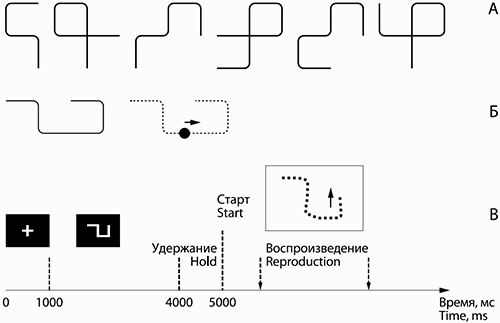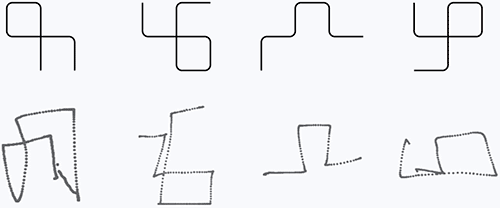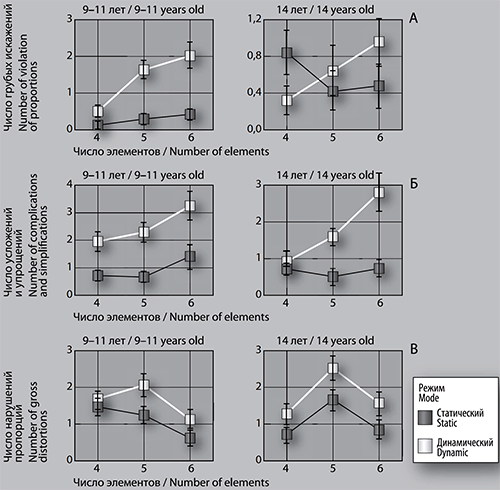Article
Korneev A.A., Lomakin D.I. (2018) Memorizing and reproducing the sequence of movements by younger schoolchildren and adolescents: age-specific mistakes. National Psychological Journal. 3, 129-138.
Abstract
Background. The paper describes the results of the experimental study of working memory in early schoolchildren and adolescents. The capacity of working memory develops through preadolescence to adolescence, while the developmental changes of representations of serial order are not clear enough so far.
Objective. The accuracy of delayed reproduction of movements (the open polygonal chains, trajectories) reveals. The sample included 32 early schoolchildren (mean age 10.4±0.75 years old) and 25 adolescents (mean age 14.6±0.3 years old). The subjects reproduced trajectories of different length (from 4 to 6 elements) using the graphical tablet. Another factor in the experiment carried out was a mode of stimulus presentation: the trajectories in were presented either as a static line-drawing (static mode) or a small moving pointer (dynamic mode).
Design. The errors of reproduction in two age groups and in different conditions were analyzed. We distinguished three types of errors: (1) severe distortions which are caused by inability to keep the sequence in working memory; (2) insertions or omissions of elements of the trajectory which are related to the problems of encoding the visual spatial information in the motor representation; (3) distortions of proportions of the trajectories, which are related with visual-motor coordination during motor reproduction of the sequences.
Research results showed that in adolescence the accuracy of delayed reproduction is better than in early ages. The most obvious difference in accuracy between the groups of early schoolchildren and adolescents were observed in dynamic mode. The analysis of different types of errors revealed that adolescents less often make insertions and omissions of elements. It may be caused by development of executive functions in adolescents.
Conclusion. The study showed that the capacity of working memory increases in adolescents. In addition, the precision of the representation of serial information are higher in adolescents in the more complicated dynamic mode.
Accepted: 02/12/2018
Pages: 129-138
DOI: 10.11621/npj.2018.0312
PDF: Download
Keywords: working memory; serial movements; graphic movements; adolescents; early schoolchildren; internal representation;
Available Online 30.09.2018

Fig. 1. Stimulus material and experimental test. A – examples of trajectories of different lengths. B – two modes of presentation: static left and dynamic right. B – time schedule of the experimental test.

Fig. 2. E in reproduction of trajectories. Upper row – samples of the trajectory, the bottom row – the answers of the test subjects. There are four types of errors (from left to right): gross distortion, complication, simplification and violation of proportions (dysmetry).

Fig. 3. The total number of errors of all four types in children of different ages in the reproduction of trajectories of different complexity, presented in different modes

Fig. 4. Mean values of errors of different types in children of different ages when playing trajectories of varying complexity, presented in different modes. A – gross violations of the trajectory; B – complications and simplification of the trajectory; B – violation of proportions of the figure elements.
References:
Alloway, T.P., Gathercole S.E., & Pickering S.J. (2006) Verbal and visuospatial short‐term and working memory in children: Are they separable? Child development, 77(6), 1698–1716. 10.1111/j.1467-8624.2006.00968.x
Akhutina, T.V., Korneev, A.A., & Matveeva, E.Yu. (2016) Methods of investigating the functions of the second block. [Metody neyropsikhologicheskogo obsledovaniya detey 6–9 let]. Moscow, 69–142.
Antonova, A.A., Absatova, K.A., Korneev, A.A., & Kurgansky, A.V. (2015) Delayed motor reproduction of non-closed polygons given by static and dynamic visual pattern: comparison of children 9–11 years old and adults. [Fiziologiya cheloveka], 41(2), 38–45.
Bisley, J.W., & Pasternak T. (2000) The multiple roles of visual cortical areas MT/MST in remembering the direction of visual motion. Cerebral Cortex, 10(11),1053–1065. doi:10.1093/cercor/10.11.1053
Conklin, H.M. et al. (2007) Working memory performance in typically developing children and adolescents: Behavioral evidence of protracted frontal lobe development. Developmental neuropsychology, 31(1), 103–128. doi:10.1207/s15326942dn3101_6
Constantinidis, C.A. (2016) Code for Cross-Modal Working Memory. Neuron, 89(1), 3–5. doi:10.1016/j.neuron.2015.12.033
Gathercolem S.E. et al. (2004) The structure of working memory from 4 to 15 years of age. Developmental psychology, 40(2», 177.
Ginsburg, V. et al. (2017) Coding of serial order in verbal, visual and spatial working memory. Journal of Experimental Psychology: General, 146(5), 632. doi:10.1037/xge0000278
Gruber, O., & von Cramon, D.Y. (2001) Domain-specific distribution of working memory processes along human prefrontal and parietal cortices: a functional magnetic resonance imaging study. Neuroscience Letters, 297(1), 29–32. doi:10.1016/S0304-3940(00)01665-7
Hurlstone, M.J., & Hitch, G.J. (2015) How is the serial order of a spatial sequence represented? Insights from transposition latencies. Journal of Experimental Psychology: Learning, Memory, and Cognition, 41(2), 295. doi:10.1037/a0038223
Hurlstone, M.J., Hitch, G.J., & Baddeley, A.D. (2014) Memory for serial order across domains: An overview of the literature and directions for future research. Psychological bulletin, 140(2), 339. doi:10.1037/a0034221
Inaba, N. et al. (2007) MST neurons code for visual motion in space independent of pursuit eye movements. Journal of Neurophysiology, 97(5), 3473–3483. doi:10.1152/jn.01054.2006
Isbell E. et al. (2015) Visual working memory continues to develop through adolescence. Frontiers in psychology, 6, 696. doi:10.3389/fpsyg.2015.00696
Kang, M.S. et al. (2011) Visual working memory contaminates perception. Psychonomic Bulletin & Review, 18(5), 860–869. doi:10.3758/s13423-011-0126-5
Korneev, A.A., & Kurgansky, A.V. (2013) Internal representation of a series of movements during the reproduction of a static pattern and the trajectory of a moving object. [Zhurnal vysshey nervnoy deyatel'nosti imeni I.P. Pavlova, 63(4), 437–450.
Lehnert, G., & Zimmer, H.D. (2008) Modality and domain specific components in auditory and visual working memory tasks. Cognitive processing, 9(1), 53–61. doi:10.1007/s10339-007-0187-6
Luciana, M., & Nelson, C.A. (2002) Assessment of neuropsychological function through use of the Cambridge Neuropsychological Testing Automated Battery: performance in 4-to 12-year-old children. Developmental neuropsychology, 22(3), 595–624. doi:10.1207/S15326942DN2203_3
Luciana M. et al. (2005) The development of nonverbal working memory and executive control processes in adolescents. Child development, 76(3), 697–712. doi:10.1111/j.1467-8624.2005.00872.x
Machizawa, M.G., & Driver, J. (2011) Principal component analysis of behavioural individual differences suggests that particular aspects of visual working memory may relate to specific aspects of attention. Neuropsychologia, 49(6), 1518–1526. doi:10.1016/j.neuropsychologia.2010.11.032
Nee, D.E., & D’Esposito, M. (2016) The Representational Basis of Working Memory. In: Current Topics in Behavioral Neurosciences. Springer, Berlin, Heidelberg, 1–18. doi:10.1007/7854_2016_456
Passolunghi, M.C., & Siegel, L.S. (2001) Short-term memory, working memory, and inhibitory control in children with difficulties in arithmetic problem solving. Journal of experimental child psychology, 80(1), 44–57. doi:10.1006/jecp.2000.2626
Pasternak, T., & Zaksas, D. (2003) Stimulus specificity and temporal dynamics of working memory for visual motion. Journal of Neurophysiology, 90(4), 2757–2762. doi:10.1152/jn.00422.2003
Pickering, S.J. et al. (2001) Development of memory for pattern and path: Further evidence for the fractionation of visuo-spatial memory. The Quarterly Journal of Experimental Psychology: Section A., 54(2), 397–420. doi:10.1080/713755973
Saults, J.S., & Cowan, N. (2007) A central capacity limit to the simultaneous storage of visual and auditory arrays in working memory. Journal of Experimental Psychology. General, 136(4), 663–684. doi:10.1037/0096-3445.136.4.663
Sekuler, R. et al. (2003) Reproduction of seen actions: stimulus-selective learning. Perception, 32(7), 839–854. doi:10.1068/p5064
Soemer, A., & Saito, S. (2016) Domain-specific processing in short-term serial order memory. Journal of Memory and Language, 88, 1–17. doi:10.1016/j.jml.2015.12.003
Spronk, M., Vogel, E.K., & Jonkman, L.M. (2012) Electrophysiological evidence for immature processing capacity and filtering in visuospatial working memory in adolescents. PLoS One, 7(8), e42262. doi:10.1371/journal.pone.0042262
Camos, V. (2017) Domain-Specific Versus Domain-General Maintenance in Working Memory: Reconciliation Within the Time-Based Resource Sharing Model. Psychology of Learning and Motivation, 67, 135–171. doi:10.1016/bs.plm.2017.03.005
Welsh, M.C., Pennington, B.F., & Groisser, D.B. (1991) A normative‐developmental study of executive function: A window on prefrontal function in children. Developmental neuropsychology, 7(2), 131–149. doi:10.1080/87565649109540483
Wing, A.M. (2000) Motor control: Mechanisms of motor equivalence in handwriting. Current biology, 10(6), R245–R248. doi:10.1016/S0960-9822(00)00375-4For citing this article:
Korneev A.A., Lomakin D.I. (2018) Memorizing and reproducing the sequence of movements by younger schoolchildren and adolescents: age-specific mistakes. National Psychological Journal. 3, 129-138.


